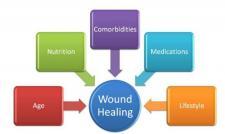Abnormal Wound Healing (Part 1)

Although we often think of the inflammatory process as something undesirable, inflammation as a process is vital to wound healing. Wounds generally progress through the phases of wound healing in an orderly fashion, but sometimes one of the phases of wound healing is altered or interrupted by internal or external factors, leading to abnormal wound healing. In this section we’ll take a look at what happens when the body’s inflammatory response is either too weak or too strong.
Inflammatory Issues- Too Much or Too Little of a Good Thing
Absence of inflammation- in the inflammatory phase, the wound is cleaned of debris and the cells that are vital to repair are signalled to come to the site of injury. When people are unable to mount an inflammatory response because of a disease process or other condition, you will be faced with a wound that is lacking in the normal signs associated with inflammation, such as redness, pain and edema. What causes a dampening of the inflammatory response? Some of the causes might include:
- high doses of steroids/non-steroidal anti-inflammatory drug
- immune system disorders (i.e. HIV/AIDS, diabetes
- autoimmune disorders
- advanced age
In order for these wounds to heal, it is necessary to provoke an inflammatory response using debridement or other methods.
Chronic inflammation- prolonged or excessive inflammation is as bad as, or worse than, no inflammation at all. In chronic inflammation, wounds become ‘stuck’ in the inflammatory phase for weeks, months and even years in some cases. In chronic inflammation, macrophages and fibroblasts proliferate. The body simply cannot build new tissue in an environment in which there is chronic inflammation. What causes chronic inflammation? Common causes include:
- foreign body in the wound bed- the body is constantly attempting to force out the offending item which should not be there; foreign objects might be a sliver of wood, a tiny piece of gauze or cotton from previous wound cleansing attempts or debris that was left behind during the initial wound cleansing
- repetitive trauma- ironically, an example of repetitive trauma is when the wrong dressing type is used, which restarts the inflammatory process every time the dressing is removed (i.e. wet-to-dry saline dressings)
- use of cytotoxic agents, which kill off the cells necessary to wound healing (i.e. Betadine, alcohol, hydrogen peroxide)
As can be seen, chronic inflammation may be provoked inadvertently by well-meaning actions, which is why it is so important to base wound care on scientific evidence, rather than relying on old and unfounded practices.
If you are interested in learning more about wound care and wound care management, Wound Educators offers online training to prepare you to become a certified wound care specialist. Visit www.woundeducators.com to learn more.
Sources
Myers, B. (2008). Wound Management Principles and Practice. 2nd Edition. Pearson Prentice Hall, Upper Saddle River, New Jersey. pg. 19-20.
Clinical Guidelines (Nursing): Wound Care. Updated July 2013. The Royal Children’s Hospital Melbourne http://www.rch.org.au/rchcpg/hospital_clinical_guideline_index/Wound_care/

Laurie,
Excellent educational newsletter. You are always spot on and we are glad to partner with you for our educational needs!
Thank you Todd, we appreciate your input and value our partnership with Wound Care Associates!.
My wife of 45 years a hole in her stomach . When you look into it you can see her intestens . She is in a Nursing Home here in Kingman Arizona and no one there knows how to take care of here. They have a wound Vac on her do to fact that we were told that she has 2 holes in her bowl . I NEED HELP .
Hi Tommy,
I am sorry to hear about your wife’s difficulty. I recommend that you contact a certified wound care specialist in your area and request a consult. You can find local certified wound care specialists here. Good luck!